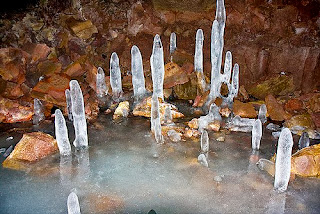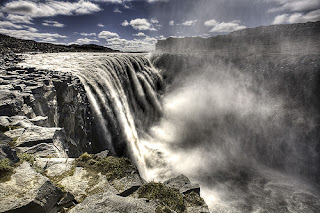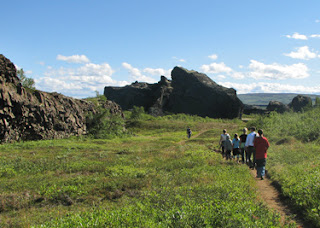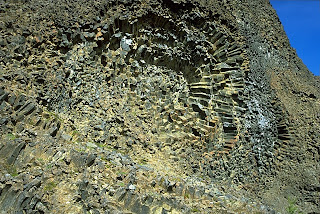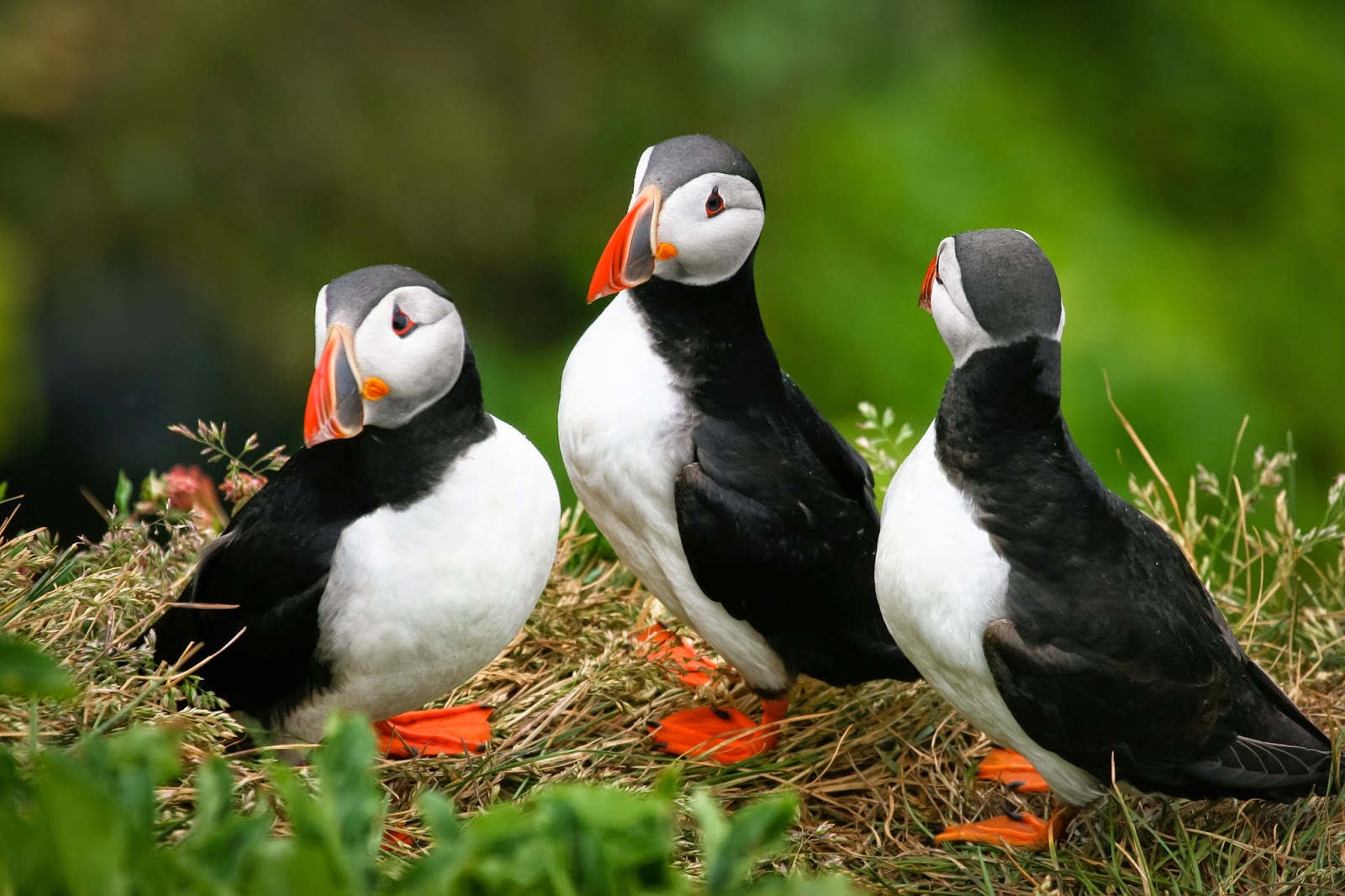For some time now we have wanted to write about the biggest town in Iceland, outside the
Reykjavík peninsula. Akureyri is one of the places you´ll end up in if you are travelling
around the island (the road ring or route 1 passes through it) and it were those visitors travelling that circle that inspired the writing of this article.
This precious town is located in the biggest fjord in Iceland (Eyjafjörður), surrounded by a beautiful mountain ring and enriched with many touristic attractions (but most of them are unknown to outsiders). With the help of Jóhanna, a local “akureyringur”, we got a detailed guide through one of the most delightful places of the island.
HistoryThe town received its first municipal rights in 1786 but lost it in 1836. In 1862 the town regained its right and from then it started growing for real. In the 19th century the town expanded rapidly and became an important industrial center, dividing itself in two different zones, the commercial traders living in the south (the most beautiful one today) while the working class built up the north area.
It´s an interesting fact that the area of the present town was once a Viking settlement, one of the most important remains of the Viking era in this place is a small bronze sculpture of the Norse thunder god Thor.
Places recommended in Akureyri and its surrounding
The botanic garden (Lystigarðurinn)
What do you think of visiting the most northern botanic garden on the planet? If yes, then you´ll find it in Akureyri. It´s located at the heart of the town offering a romantic stroll amidst amazing diversion of colorful flowers, especially recommended in the heap of summer.
The garden was established in 1912 by a group of women but today its own by the town. In it you can find almost all the flowers and plants existing in Iceland as well as over 6000 foreign species. We recommend after a walk to sit down for a coffee and cake at the coffee house “Björk” which is located in the middle of the garden. Here you´ll find a detailed plan of the place.
The botanic garden is open from the 1st of June until the 3th of September with the opening hours from 08.00 until 22.00 (free entrance).
The swimming pool of Akureyri
Even though there is couple of swimming pools in and around Akureyri, the one we like the most is a walking distance from the botanic garden, as well in the middle of the town. Going there after a stroll in the botanic garden is a fantastic way to finish the tour.
The swimming pool (called Akureyrarlaug) is almost completely outdoor and has alot to offer in terms of relaxation and of course, exercise. There are two big swimming pools, a splashpool for the little ones, 4 hot tubs (each being at different temperatures), steam bath, 3 water slides, an extensive area for sunbathing and a perfect artificial waterfall to relax your back and have a natural water massage. All the pools are heated by natural geothermal water and the temps range from a pleasant 27°C to the hottest pot at 42°C.
The swimming pool of Akureyri is open all year around and you can rent both swimsuits and towels. Weekdays it´s open until 21.00 and to 19.30 at weekends.
The Christmas house (Jólagarðurinn)
Located 10 km south of Akureyri, this adorable little Christmas garden and a store are open all year around and has an amazing variety of decorations, local handicrafts, ornaments and sweets all related to Christmas.
The outside of the red house resembles a house made of cookies and inside the decoration is impressive. Around the house there is a beautifully decorated garden, ideal for picnic. It even has a fairy tale tower which hosts the world´s biggest Christmas calendar (makes it worth climbing the stairs).
Traditional Icelandic houses (Laufás)
You´ll find these farmhouses just 20 minutes with a car from Akureyri and they are considered as a prototype of the old traditional Icelandic architecture. The oldest house still standing was built in 1840 but there has also been a church located at Laufás since the earliest period of Christianity in Iceland.
What immediately calls for an attention are the roofs of the houses which are covered with grass but that gave a “natural isolation” against the cold. At times, there was between 20 and 30 people living in Laufás and the last inhabitants lived there in 1936.
Now the houses are maintained as a museum as well as you´ll find a restaurant and a souvenir shop. The museum is open every day from 09.00-18.00 (from 15th of May until 15th of September). On Thursdays they have open until 22.00.To get to Laufás you´ll have to take route 1 in the direction east and take the exit 83 in the direction to Grenivík. You can see Laufás from the road (it´s easy to reach).
The ski resort (Hlíðarfjall)
Without a doubt this is one of the best places in Iceland to practice this winter sport. The mountain rises above the town and the view up there is breathtaking. There you can do downhill skiing and cross country skiing, snowboarding or whatever you feel like with over three ski lifts to take you up the mountain. You don´t need to bring your own equipment, you can rent all of it there.
Hlíðarfjall is situated 500m- 1000m above sea level so in the winter there is alot of snow, an ideal condition for skiing. It´s only 5 km from the town and it is usually open from early december through april, depending on the amount of snow each year. You can see the opening hours in the following link and the price list here.
The forest of Akureyri (Kjarnaskógur)
South of the town, just above the airport, you´ll find Kjarnaskógur, a small but perfect place for an afternoon stroll, picnic or just to relax with your family. There are plenty of small routes all over the proximately 600 acres and it´s estimated that there are around 1 million trees in the area, many of them planted in the last 50 years.
There is one simple route of 7km that we recommend as well as another 10km designed for mountain bikes. There are also two playgrounds, picnic areas, barbecue facilities, toilets and a volleyball court. For bird lovers, it also has a rich wildlife and even a bird sanctuary.
Grímsey
Even it´s not located in Akureyri, we cannot help to mention Grímsey, an island located 150 km north of Akureyri, a place totally recommended for bird lovers, especially lovers of puffins. On this island there are cliffs filled with thousands of these tiny cute birds. It´s an unique experience to see that island.
There is a direct flight connection Akureyri - Grímsey but it´s also possible to take a bus + boat to get there. We already have a more detailed article about Islands of Iceland which you
can find here.
Where to sleep?
In Akureyri there are plenty of hotels, guesthouses and hostels to pass the night but we would like to make one special suggestion: Elf Guesthouse.
This is a guesthouse run by an elderly couple on the other side of the fjord (about 2 km from the town center) but they have built a gorgeous little wooden hut in a small forest next to a big stone which is said to be the home of an Elf.
If we are not mistaken, the Elf Guesthouse only has one other house nearby where the Icelandic couple lives in their own land of 200 square meters. According to Karl (the owner and a local carpenter), when they bought the land one of the condition that the seller made was that they would not “disturb” the elf nor built on or demolish the stone.
That promise they have kept, a garden around the stone is beautifully kept with lovely trees, flowers and ornaments. This place is the most romantic and amazing that you can imagine it´s like a small paradise. It only offers the possibility of renting the house to a couple. Direct contact with Karl is info@elfguesthouse.com
Where to eat?
Even though it may sound unbelievable there are many dining options in this small town of 18.000 inhabitants, all with different taste and budget. We will recommend four places we think are interesting for several reasons:
Bautinn. This restaurant is right in the town center and offers a classic menu for medium price. We recommend trying out the horse meat but all the main dishes come with a soup and a salad bar.
Rub23. This is the best restaurant in Akureyri and one of the top 5 in Iceland (the owner has another restaurant in Reykjavík). Here all the food is of high quality, an excellent wine menu and we highly recommend trying their specialty: sushi pizza.
1862 Nordic Bistro. Located in the cultural center HOF and offers a magnificent view with dishes and food typical of Denmark.
Strikið. Situated at the 5th floor, next to the main street of Akureyri. This place has a nice lounge atmosphere, quality food, good wine and gorgeous view. What more do you need?
To top it off here we have a link where you can view schedules of different activities, restaurants, museums, transportation, travel agencies, supermarket, drug stores, ice cream parlors and cafes in Akureyri. There were so many other places we could have mentioned but we don´t want to overdo it. What a piece of an article!Kolla and Jóhanna
© 2015 by Iceland24



